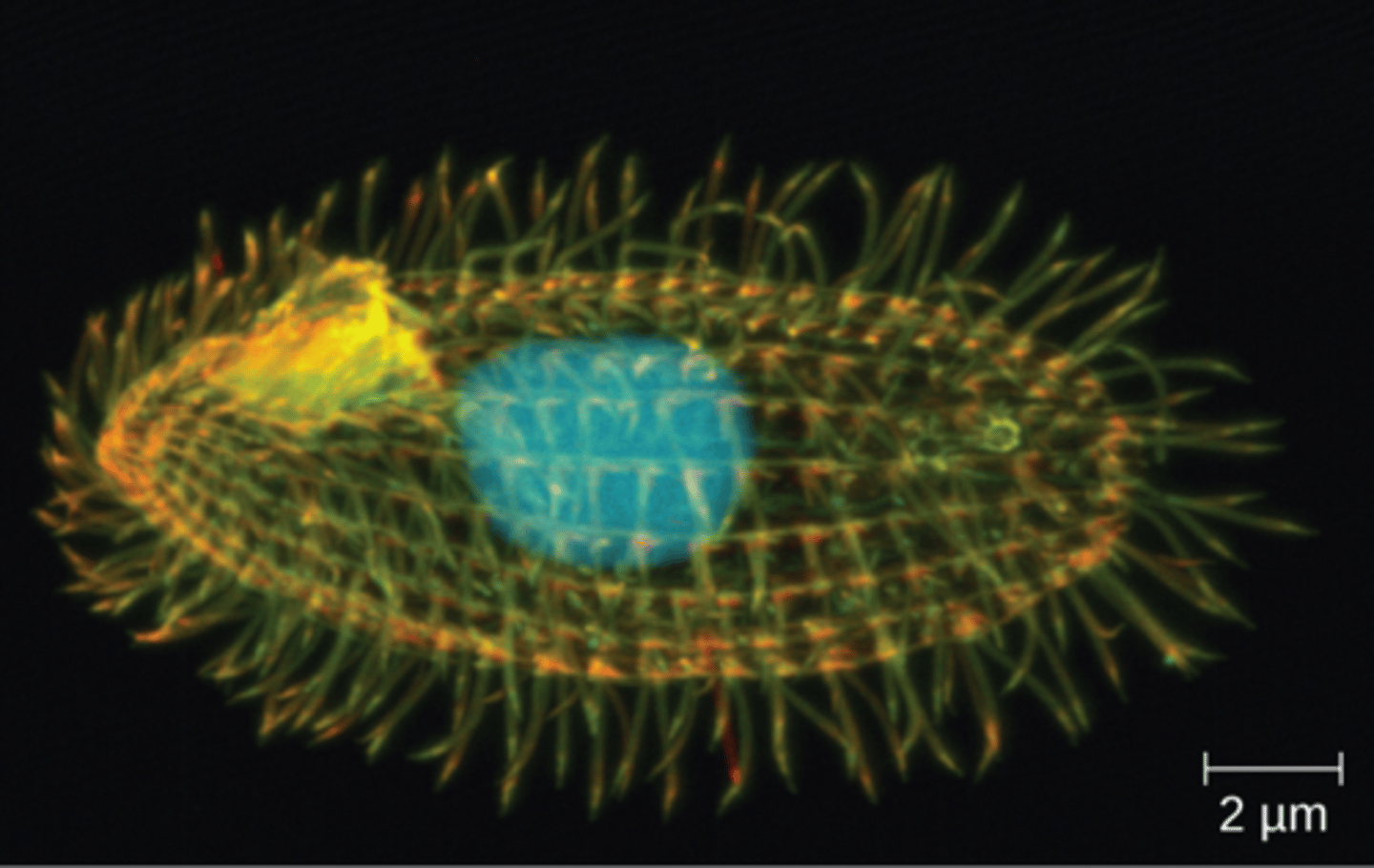Chapter 5 Questions
1/37
There's no tags or description
Looks like no tags are added yet.
Name | Mastery | Learn | Test | Matching | Spaced |
|---|
No study sessions yet.
38 Terms
Which genus includes the causative agent for malaria?
A. Euglena
B. Paramecium
C. Plasmodium
D. Trypanosoma
C. Plasmodium
Which protist is a concern because of its ability to contaminate water supplies and cause diarrheal illness?
A. Plasmodium vivax
B. Toxoplasma gondii
C. Giardia lamblia
D. Trichomonas vaginalis
C. Giardia lamblia
A fluke is classified within which of the following?
A. Nematoda
B. Rotifera
C. Platyhelminthes
D. Annelida
C. Platyhelminthes
A nonsegmented worm is found during a routine colonoscopy of an individual who reported having
abdominal cramps, nausea, and vomiting. This worm is likely which of the following?
A. nematode
B. fluke
C. trematode
D. annelid
A. nematode
A segmented worm has male and female reproductive organs in each segment. Some use hooks to attach to
the intestinal wall. Which type of worm is this?
A. fluke
B. nematode
C. cestode
D. annelid
C. cestode
Mushrooms are a type of which of the following?
A. conidia
B. ascus
C. polar tubule
D. basidiocarp
D. basidiocarp
Which of the following is the most common cause of human yeast infections?
A. Candida albicans
B. Blastomyces dermatitidis
C. Cryptococcus neoformans
D. Aspergillus fumigatus
A. Candida albicans
Which of the following is an ascomycete fungus associated with bat droppings that can cause a respiratory
infection if inhaled?
A. Candida albicans
B. Histoplasma capsulatum
C. Rhizopus stolonifera
D. Trichophyton rubrum
B. Histoplasma capsulatum
Which polysaccharide found in red algal cell walls is a useful solidifying agent?
A. chitin
B. cellulose
C. phycoerythrin
D. agar
D. agar
Which is the term for the hard outer covering of some dinoflagellates?
A. theca
B. thallus
C. mycelium
D. shell
A. theca
Which protists are associated with red tides?
A. red algae
B. brown algae
C. dinoflagellates
D. green algae
C. dinoflagellates
You encounter a lichen with leafy structures. Which term describes this lichen?
A. crustose
B. foliose
C. fruticose
D. agarose
B. foliose
Which of the following is the term for the outer layer of a lichen?
A. the cortex
B. the medulla
C. the thallus
D. the theca
A. the cortex
The fungus in a lichen is which of the following?
A. a basidiomycete
B. an ascomycete
C. a zygomycete
D. an apicomplexan
B. an ascomycete
The plasma membrane of a protist is called the __________.
plasmalemma
Animals belong to the same supergroup as the kingdom __________.
Fungi
Flukes are in class _________.
Trematoda
A species of worm in which there are distinct male and female individuals is described as _________.
dioecious
Nonseptate hyphae are also called _________.
coenocytic
Unicellular fungi are called _________.
yeasts
Some fungi have proven medically useful because they can be used to produce _________.
antibiotics
Structures in chloroplasts used to synthesize and store starch are called ________.
pyrenoids
Algae with chloroplasts with three or four membranes are a result of ________ ________.
secondary endosymbosis
What are kinetoplastids?
Modified mitochondria present in protozoa.
Aside from a risk of birth defects, what other effect might a toxoplasmosis infection have?
Behavioral and personality alterations
What is the function of the ciliate macronucleus?
Sexual reproduction; macronucleus contains the genes for metabolism
What is the best defense against tapeworm infection?
Vaccination and treatment of the disease in animals. Also, cooking the meat appropriately to kill the organism is the best method of defense.
Which genera of fungi are common dermatophytes (fungi that cause skin infections)?
ascomycetes
What is a dikaryotic cell?
A cell with two nucleuses
What is a distinctive feature of diatoms?
The outer cell walls of diatoms contain characteristics "frustules" made of crystallized silica.
Why are algae not considered parasitic?
They carry out photosynthesis
Which groups contain the multicellular algae?
brown, red, green
What are three ways that lichens are environmentally valuable?
1. fix nitrogen and act as a nitrogen source in some enviroments 2. important soil stabilizers 3. important winter food source.
The protist shown has which of the following?
D. cilia

Protist taxonomy has changed greatly in recent years as relationships have been re-examined using newer
approaches. How do newer approaches differ from older approaches?
Newer approaches are using newer techniques based off of biochemistry, morphology and genetics
What characteristics might make you think a protist could be pathogenic? Are certain nutritional
characteristics, methods of locomotion, or morphological differences likely to be associated with the ability to
cause disease?
Heterotrophic (feeding character). A lack of organelles for locomotion are more likely to be parasitic or pathogenic.
Given the life cycle of the Schistosoma parasite, suggest a method of prevention of the disease.
Avoid going in water/wet places, don't eat undercooked meat, and stay away from the equator
Explain the benefit of research into the pathways involved in the synthesis of chitin in fungi.
They try to find differences in human and fungal cells so that the drugs don't harm our cells - since fungal cells have chitin and we don't, antifungal drugs can be made to target the chitin cell walls